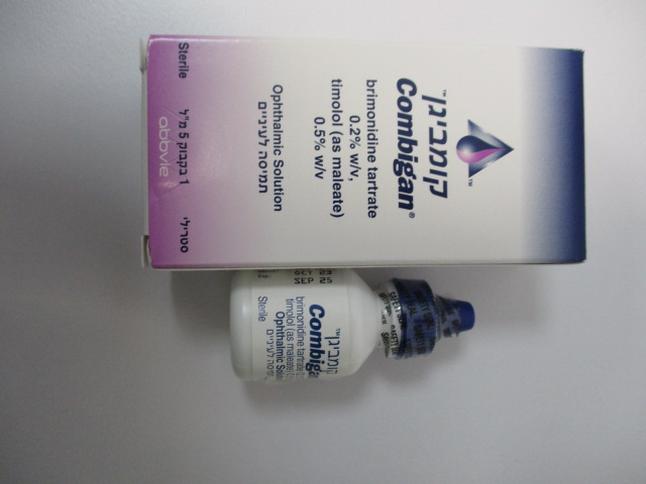Quest for the right Drug

קומביגן COMBIGAN (BRIMONIDINE TARTRATE, TIMOLOL, TIMOLOL AS MALEATE)
תרופה במרשם
תרופה בסל
נרקוטיקה
ציטוטוקסיקה
צורת מתן:
עיני : OCULAR
צורת מינון:
אין פרטים : EYE DROPS, SOLUTION
עלון לרופא
מינוניםPosology התוויות
Indications תופעות לוואי
Adverse reactions התוויות נגד
Contraindications אינטראקציות
Interactions מינון יתר
Overdose הריון/הנקה
Pregnancy & Lactation אוכלוסיות מיוחדות
Special populations תכונות פרמקולוגיות
Pharmacological properties מידע רוקחי
Pharmaceutical particulars אזהרת שימוש
Special Warning עלון לרופא
Physicians Leaflet
Pharmacological properties : תכונות פרמקולוגיות
Pharmacodynamic Properties
12.1 Mechanism of Action COMBIGAN® is comprised of two components: brimonidine tartrate and timolol. Each of these two components decreases elevated intraocular pressure, whether or not associated with glaucoma. Elevated intraocular pressure is a major risk factor in the pathogenesis of optic nerve damage and glaucomatous visual field loss. The higher the level of intraocular pressure, the greater the likelihood of glaucomatous field loss and optic nerve damage. COMBIGAN® is a relatively selective alpha-2 adrenergic receptor agonist with a non- selective beta-adrenergic receptor inhibitor. Both brimonidine and timolol have a rapid onset of action, with peak ocular hypotensive effect seen at two hours post-dosing for brimonidine and one to two hours for timolol. Fluorophotometric studies in animals and humans suggest that brimonidine tartrate has a dual mechanism of action by reducing aqueous humor production and increasing uveoscleral outflow. Timolol maleate is a beta1 and beta2 adrenergic receptor inhibitor that does not have significant intrinsic sympathomimetic, direct myocardial depressant, or local anesthetic (membrane-stabilizing) activity.
Pharmacokinetic Properties
12.3 Pharmacokinetics Absorption Systemic absorption of brimonidine and timolol was assessed in healthy volunteers and patients following topical dosing with COMBIGAN®. Normal volunteers dosed with one drop of COMBIGAN® twice daily in both eyes for seven days showed peak plasma brimonidine and timolol concentrations of 30 pg/mL and 400 pg/mL, respectively. Plasma concentrations of brimonidine peaked at 1 to 4 hours after ocular dosing. Peak plasma concentrations of timolol occurred approximately 1 to 3 hours post-dose. In a crossover study of COMBIGAN®, brimonidine tartrate 0.2%, and timolol 0.5% administered twice daily for 7 days in healthy volunteers, the mean brimonidine area-under- the-plasma-concentration-time curve (AUC) for COMBIGAN® was 128 ± 61 pg•hr/mL versus 141 ± 106 pg•hr/mL for the respective monotherapy treatments; mean Cmax values of brimonidine were comparable following COMBIGAN® treatment versus monotherapy (32.7 ± 15 pg/mL versus 34.7 ± 22.6 pg/mL, respectively). Mean timolol AUC for COMBIGAN® was similar to that of the respective monotherapy treatment (2919 ± 1679 pg•hr/mL versus 2909 ± 1231 pg•hr/mL, respectively); mean Cmax of timolol was approximately 20% lower following COMBIGAN® treatment versus monotherapy. In a parallel study in patients dosed twice daily with COMBIGAN®, twice daily with timolol 0.5%, or three times daily with brimonidine tartrate 0.2%, one-hour post dose plasma concentrations of timolol and brimonidine were approximately 30-40% lower with COMBIGAN® than their respective monotherapy values. The lower plasma brimonidine concentrations with COMBIGAN® appears to be due to twice-daily dosing for COMBIGAN® versus three-times dosing with brimonidine tartrate 0.2%. Distribution The protein binding of timolol is approximately 60%. The protein binding of brimonidine has not been studied. Metabolism In humans, brimonidine is extensively metabolized by the liver. Timolol is partially metabolized by the liver. Excretion In the crossover study in healthy volunteers, the plasma concentration of brimonidine declined with a systemic half-life of approximately 3 hours. The apparent systemic half-life of timolol was about 7 hours after ocular administration. Urinary excretion is the major route of elimination of brimonidine and its metabolites. Approximately 87% of an orally-administered radioactive dose of brimonidine was eliminated within 120 hours, with 74% found in the urine. Unchanged timolol and its metabolites are excreted by the kidney. Special Populations COMBIGAN® has not been studied in patients with hepatic impairment. COMBIGAN® has not been studied in patients with renal impairment. A study of patients with renal failure showed that timolol was not readily removed by dialysis. The effect of dialysis on brimonidine pharmacokinetics in patients with renal failure is not known. Following oral administration of timolol maleate, the plasma half-life of timolol is essentially unchanged in patients with moderate renal insufficiency.

שימוש לפי פנקס קופ''ח כללית 1994
לא צוין
תאריך הכללה מקורי בסל
03/01/2010
הגבלות
תרופה מוגבלת לרישום ע'י רופא מומחה או הגבלה אחרת
מידע נוסף
עלון מידע לצרכן
23.04.17 - עלון לצרכן אנגלית 23.04.17 - עלון לצרכן עברית 23.04.17 - עלון לצרכן ערבית 08.06.23 - עלון לצרכן עברית 12.08.23 - עלון לצרכן אנגלית 12.08.23 - עלון לצרכן עברית 12.08.23 - עלון לצרכן ערבית 02.05.24 - עלון לצרכן עברית 07.05.24 - עלון לצרכן אנגלית 07.05.24 - עלון לצרכן ערבית 20.09.24 - עלון לצרכן עברית 25.06.13 - החמרה לעלון 27.11.16 - החמרה לעלון 16.05.24 - החמרה לעלון 20.09.24 - החמרה לעלוןלתרופה במאגר משרד הבריאות
קומביגן